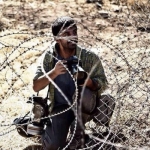Coming home to Kobane
KOBANE, Syria, March 27, 2015 – I travelled to Kobane a day before Newroz, the Kurdish New Year, and stayed for a week to photograph people returning to their homes, two months after the Kurds recaptured the town from Islamic State fighters.
The last time I was here, just after the Islamists were chased out, the place was strewn with burning cars and corpses. There are still clashes going on just 30 kilometres away, but there are no combat forces in Kobane and you get no sense of the ongoing fighting when you are in the town.
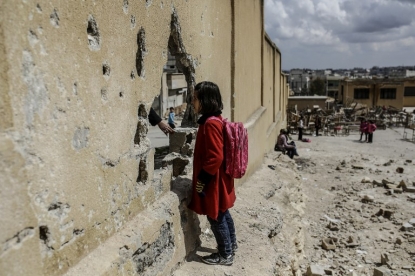 A Syrian schoolgirl beside a damaged wall at her school in Kobane on March 25, 2015 (AFP Photo / Yasin Akgul)
A Syrian schoolgirl beside a damaged wall at her school in Kobane on March 25, 2015 (AFP Photo / Yasin Akgul)Two months on, there are signs of normal life beginning to resume. Almost eighty percent of the town appears to have been destroyed, but you can see people lighting fires here and there, discussing when their houses can be rebuilt, and trying their best to start cleaning up on their own. Some shops have already reopened – although most people have no money to spend.
 A Kurdish man works in a bread factory in Kobane on March 22, 2015 (AFP Photo / Yasin Akgul)
A Kurdish man works in a bread factory in Kobane on March 22, 2015 (AFP Photo / Yasin Akgul)As far as I know, around 5,000 people have returned home so far. Most of those I met were deeply unhappy. They have lost either their homes, their relatives, or both. I saw one family moving their possessions from one house to another on the back of a truck, another lugging a carpet out of his gutted home.
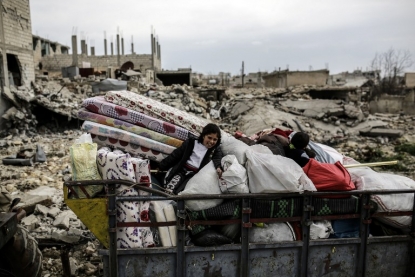 Kurdish Syrians returning home to Kobane on March 24, 2015 (AFP Photo / Yasin Akgul)
Kurdish Syrians returning home to Kobane on March 24, 2015 (AFP Photo / Yasin Akgul)Many others do not want to return before their houses have been repaired, and choose to stay on in nearby camps, including over the Turkish border in Suruc. Those who do come back can get some logistical help from the local authorities.
 Schoolchildren play at recess outside their school in Kobane on March 25, 2015 (AFP Photo / Yasin Akgul)
Schoolchildren play at recess outside their school in Kobane on March 25, 2015 (AFP Photo / Yasin Akgul)At the school I visited, much of which was destroyed by gunfire, there are five classes operating, with about 200 students attending. Tuition is now being offered in Kurdish, whereas before it was Arabic only.
 A Kurdish boy plays with a disused power cable in Kobane on March 24, 2015 (AFP Photo / Yasin Akgul)
A Kurdish boy plays with a disused power cable in Kobane on March 24, 2015 (AFP Photo / Yasin Akgul)On the street the kids entertain themselves however they can – like these boys swinging on an electric cable, a harmless game since there is no power supply here.
People rely on generators, although some homes have to do without, and fuel supplies are already starting to dwindle. They light fires to keep warm, and heat water for cooking and bathing – like this little girl sitting in the rubble.
 Kurdish Syrian girls among destroyed buildings in Kobane on March 22, 2015. (AFP Photo / Yasin Akgul)
Kurdish Syrian girls among destroyed buildings in Kobane on March 22, 2015. (AFP Photo / Yasin Akgul)You can still see some armed guys hanging around, but the Syrian Kurdish fighters of the PYD, who hold the town, don’t officially allow anyone else to walk around in military garb or with guns. At the eastern door to the town, in a street that saw the worst of the fighting, stand the remnants of a sign that once read “Welcome to Kobane”.
 What's left of a 'Welcome to Kobane' sign at the town entrance on March 24, 2015 (AFP Photo / Yasin Akgul)
What's left of a 'Welcome to Kobane' sign at the town entrance on March 24, 2015 (AFP Photo / Yasin Akgul)This was my fourth trip to Kobane. I have watched this whole tragedy unfold from the Turkish side since last September, and seen how people have suffered in the dust and dirt.
So I was happy to shoot this series of portraits of women of Kobane, wearing their finest clothes for Newroz. I hope they can carry a symbolic message of optimism, in the yellow, green and red of the Kurdish identity.
Yasin Akgul is a Turkish freelance photographer and AFP contributor. Find more examples of his work here.
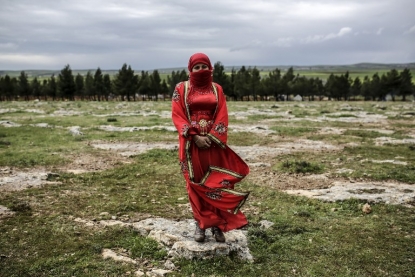 A Syrian Kurdish woman poses during a gathering to celebrate Newroz in Kobane on March 21, 2015. (AFP Photo / Yasin Akgul)
A Syrian Kurdish woman poses during a gathering to celebrate Newroz in Kobane on March 21, 2015. (AFP Photo / Yasin Akgul)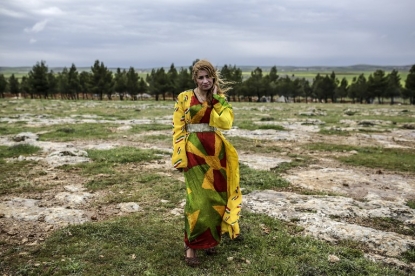 A Syrian Kurdish woman poses during a gathering to celebrate Newroz in Kobane on March 21, 2015. (AFP Photo / Yasin Akgul)
A Syrian Kurdish woman poses during a gathering to celebrate Newroz in Kobane on March 21, 2015. (AFP Photo / Yasin Akgul) A Syrian Kurdish woman poses during a gathering to celebrate Newroz in Kobane on March 21, 2015. (AFP Photo / Yasin Akgul)
A Syrian Kurdish woman poses during a gathering to celebrate Newroz in Kobane on March 21, 2015. (AFP Photo / Yasin Akgul)

